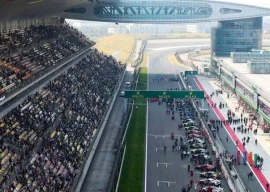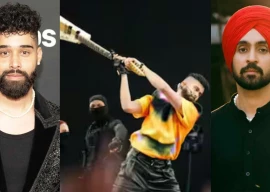
KARACHI: As the Mohatta Palace Museum opened its doors to display works created by 42 artists from across the country between 1990 and 2010, it wasn’t just the sheer magnitude of the exhibition that took one’s breath away. Divided into six theme-based wings, “The Rising Tide” is the first contemporary show of its kind to take place at Mohatta, which encompasses the diverse talents of artists who have made their mark on the Pakistani art scene.
Drawing an overwhelming response from the crème de la crème of Karachi who graced the occasion with their presence, the show satisfied a growing need among the people for a space that could pay tribute to the art being produced in the country.
Rashid Rana stole the show with his larger than life piece, titled “Desperately seeking paradise”. A glass cube depicting the skyline of the metropolis, Rana constructed the piece in keeping with his patent style - a photo montage of tiny images that captures scenes from the streets of Lahore. Part of the “Cartographies of Intimacy” theme, Rana’s work embodied the essence of Pakistan’s history with colonial, modern, urban and nationalistic nuances. These were echoed in works by Roohi Ahmed as well, whose “Mobius Karachi” - a sculpture made out of maps of the city - was a comment on the history of the city as well as the artist’s own experiences while living in Karachi. Durriya Kazi and David Alesworth collaborated on a series that revolved around truck art, while Imran Qureshi’s “You are my love and my life’s enemy too?” compelled a viewer to look at the political and social comment seeping through the blood-coloured paint.
Ayaz Jokhio’s “99 self portraits” - a part of “The Urban Transition” wing at the museum - was the artist’s way of exploring the various facets of his own identity under the influences of his surroundings. Pieces by Jamil Baloch, Malcolm Hutcheson and Farida Batool also revolved around the lines of an artist’s journey through a multifaceted and shifting lens that permits glimpses of everyday life within the urban context.
Meanwhile, Nausheen Syed managed to extract an overwhelming response from the audience through her “Based Delicacies” - parts of the human body that Syed managed to sculpt out of bread. Her work was part of the “Languages of Belonging” theme, in which Nusra Latif’s “Did you come here to find history?” also managed to stir many questions pertaining to the identity of a modern Pakistani living under the influences of the past. Questioning and translating the traditions surrounding us and their significance in the contemporary practices, these artists portrayed the complex relation between tradition and modernity in their work.
A poignant part of the exhibition was the final series of work produced by Asim Butt - a unique and unseen documentation of the artist’s last road trip around Pakistan, in which he had left his political comments on the walls of the country. Asim Butt’s work was featured in “Between the Real and the Fabricated”- a wing dedicated to recreating, dismantling, erasing and reinventing history through art. The wing also featured an installation by Aisha Khalid.
Mehreen Murtaza’s “Divine Invasion” - a digitally manipulated print depicting the chaotic nature of Karachi - was part of the “Imagined Worlds Envisioning Spaces” theme, which was based on artists’ comments on their practices while living in a certain space. Works by Arif Mahmood, Hamra Abbas, Afshar Malik and Mansur Salim were also exhibited in the wing.
The last section of the show - “Ghosts in the Turret Room” - exhibited a selection of video art and installations by Auj Khan, Noor Yousof and Asma Mundrawala, among others, who tried to depict their concerns while living in an urban landscape in their work.
The exhibition has been curated by Naiza Khan and will continue till February 28 at the Mohatta Palace Museum.
Published in The Express Tribune, October 30th, 2010.


















1713264570-0/Tribune-Collage-Feature-Images-(9)1713264570-0-270x192.webp)



















COMMENTS
Comments are moderated and generally will be posted if they are on-topic and not abusive.
For more information, please see our Comments FAQ